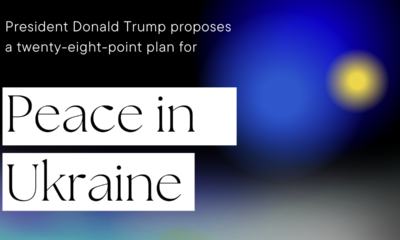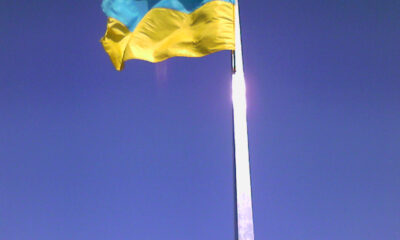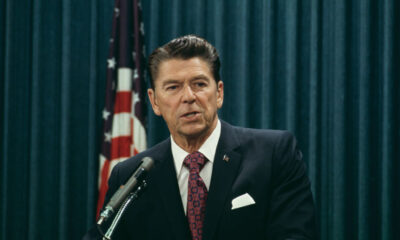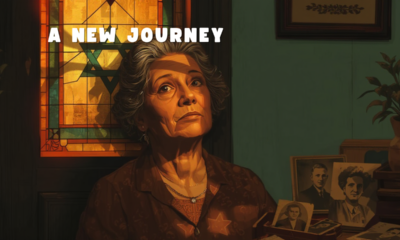Guest Columns
Putin’s Myths vs. Ukraine’s Truths
Presenting a history of Kievan Rus’ and a theory that Russia and Ukraine are each separate and equal outgrowths of that polity.

The interview with Vladimir Putin left me wide awake for nearly two hours before I could finally drift off to sleep. Despite being familiar with the content, it was Vladimir Putin’s skillful distortion of history and manipulation of facts, combined with his remarkable mental sharpness at age 70, that really struck me. Despite the Russian military’s challenges in Ukraine, Putin’s strength lies beyond conventional military strategy. His expertise in navigating the ambiguous “grey zone” will continue to significantly influence global outcomes.
Understanding the complexity of Ukraine’s identity within the broader Slavic-Orthodox civilization requires recognizing that, despite shared historical and cultural roots with Russia, Ukraine possesses distinct cultural, economic, political, and identity values. This distinction is most pronounced in the realm of political identity. Russia’s ambition has been to reassert its status as a major power, contrasting sharply with Ukraine’s post-independence vision.
Prior to the war, Ukrainians had consistently advocated for a political identity that aligned with the country’s geographical realities, asserted its sovereignty, and pursued favorable relations with its neighbors, including Moscow. This stance was a direct outcome of Ukraine’s historical journey, notably the integration of its western regions post-World War II and the dissolution of the Soviet Union, which left its population seeking a new political direction. The absence of the Soviet Union prompted a significant shift towards independence, fueled by the aspirations for autonomy that had been present during the Soviet era, and the potential for a more prosperous economic future.
In the years following independence, the principle of sovereignty had emerged as a foundational aspect of Ukraine’s foreign policy, a stance common among its leaders. This had led to a decrease in support for radical parties, whether they advocated for severing ties with Russia or for closer integration, reflecting a pragmatic consensus on maintaining Ukraine’s sovereignty while managing its relationship with Moscow. Leaders such as Kuchma, Yushchenko, Tymoshenko, and Yanukovych had all supported the sovereignty of Ukraine and the importance of favorable relations with Russia, illustrating a unified approach across different administrations.
Despite a significant alignment on issues of sovereignty and foreign relations, Ukraine has always navigated a complex cultural and civilizational landscape. The coexistence of Slavic-Orthodox and Western influences within Ukraine underscored the enduring diversity of its cultural, traditional, and religious practices. The dialogue between these civilizations within Ukraine suggested that, while unity in sovereignty was strong, cultural, and civilizational differences persisted, shaped by centuries of divergent historical experiences and influences.
Absent the Russian war in Ukraine, the potential for Ukraine’s economic and social conditions to improve would have offered a pathway towards further reducing these civilizational divides. Particularly, Ukraine’s integration into the European Union could have served as a catalyst for unity, bridging the gap between its diverse influences. This evolution would have come about due to the dynamic nature of Ukraine’s identity.
In the 12th century, the proto-state of Kievan Rus began to fragment, leading to the emergence of fifteen distinct states from its territories, notable among which were the Principality of Vladimir-Suzdal and the Kingdom of Galicia-Volhynia. These two regions would lay the historical and cultural foundations for Russia and Ukraine, respectively. Situated at the extreme edges of the former Kievan Rus, they embarked on divergent paths of development influenced by their unique external interactions, which played a pivotal role in shaping their distinct ethnic identities, political frameworks, and economic systems. Despite these differences, both regions retained Christianity, a faith introduced to Kievan Rus by Vladimir the Great shortly before the year 1000.
The Mongol invasion of Kievan Rus’ territories further widened the gap between these emerging regions. The Principality of Vladimir-Suzdal, opted for collaboration over resistance, and came under strong Mongol influence in its politics, society and culture. In contrast, the Kingdom of Galicia-Volhynia, benefitting from its geographical remoteness, offered greater resistance to the Mongols and thus experienced a lesser degree of influence. This divergence in experiences with the Mongol invasion led the Kingdom of Galicia-Volhynia to align more closely with the civilizations of Eastern and Western Europe, including Bohemia, Hungary, Poland, and even Austria. Meanwhile, Vladimir-Suzdal developed ties with Mongol and Finno-Ugric tribes, integrating Mongol imperial governance models into its political structure.
The geographic and climatic conditions of each area also contributed to their distinct developmental paths. The Principality of Vladimir-Suzdal, characterized by poor soil and harsh climates, fostered a community-oriented society aimed at collective benefit. Scholars like Subtelny and Czubatyj have highlighted the role of ethnic and anthropological differences, as well as divergent socio-economic organizations, in defining the Russian and Ukrainian peoples’ distinct identities.
A crucial turning point came with the Polish and Lithuanian invasion of the Kingdom of Galicia-Volhynia in 1340, leading to a significant cultural and religious shift following the Treaty of Lublin in 1569, under which Poland assumed control over the territory. Increased Polish pressure, particularly in the realms of culture and religion, culminated in the Union of Brest in 1596. This event saw the nobility of the Kingdom of Galicia-Volhynia embracing Catholicism, albeit with the retention of the Orthodox rite, as a means to preserve their status amid forced Catholicization. This religious shift marked a definitive alignment of the Kingdom of Galicia-Volhynia with Western civilization, contrasting with the Principality of Vladimir-Suzdal’s continued path within the Slavic-Orthodox sphere.
The peasants of Galicia-Volhynia opposed the agreement with the Polish nobility, which imposed heavy labor, high taxes, and pressures to convert to Catholicism. Many fled to southern Ukraine, founding the Zaporizhian Sich, a community that quickly became a significant political and military force, even challenging Polish control and asserting dominance over Kyiv and central Ukraine. This was a pivotal moment, marking the rise of the Cossacks. In 1648, a rebellion led to the establishment of the Cossack Hetmanate, declaring independence from Poland. Despite this, Poland continued its attacks, forcing the Hetmanate to seek protection from Russia, which led to the Treaty of Pereyaslav in 1654. This treaty initiated the Hetmanate’s gradual integration into the Russian Empire, largely motivated by the mutual interest in defending the Orthodox faith, especially against the backdrop of the Union of Brest in 1596, which had signified the Catholic push eastward.
The late 18th century saw Poland and Russia vying for control over the Hetmanate and Galicia-Volhynia. The 1686 agreement concluded this struggle, placing Kyiv and Zaporizhia under Russian control while leaving Galicia-Volhynia with Poland. This division underscored the existing civilizational differences within Ukraine, tracing back to the disintegration of Kievan Rus and the distinct paths taken by its successor states, the Principality of Vladimir-Suzdal and the Kingdom of Galicia-Volhynia.
Over time, the inhabitants of these regions began to assimilate new cultures and lifestyles, reflecting their political affiliations with either Poland or the Russian Empire. The Russian Empire, in particular, embarked on a policy to erode the autonomy of the Hetmanate, integrating it into the empire’s broader socio-political and economic framework. This included administrative and educational reforms, legal changes, and the promotion of migration from other parts of the empire, seeking to change the Hetmanate’s distinct identity. The Tsarist regime also deployed the Hetmanate’s population for labor-intensive projects across the empire, further attempting to weaken the Cossacks’ warrior spirit.
Despite these assimilation efforts, the Hetmanate’s traditions, such as the Ukrainian language, were maintained. The Tsarist policy also led many Hetmanate intellectuals, who preserved the region’s traditional culture, to relocate to Saint Petersburg, where they found acceptance and opportunities within the Tsarist administration. This integration process, which continued into the 19th and 20th centuries, explains why there was no immediate push for independence during the revolutions of 1917 and 1991. The population had largely identified with the Tsarist Empire’s society, culture, and religion. However, the undercurrents of national identity and the desire for political autonomy persisted, especially among intellectuals and peasants who cherished the Hetmanate’s traditional culture. These sentiments occasionally surfaced, particularly in the first half of the 19th century, advocating for cultural recognition and political autonomy but not outright independence. The Tsarist Empire’s late 19th-century policies aimed at cultural unification faced challenges, particularly with the national awakenings across the empire, prompting fears of independence movements among its diverse regions.
The division of Poland at the end of the 18th century resulted in the Kingdom of Galicia-Volhynia coming under the control of the Austro-Hungarian and Tsarist Empires, marking a pivotal moment for the inhabitants of these regions. Unlike the Tsarist regime, the Austro-Hungarian Empire did not enforce a uniform cultural model across its diverse territories, given its multi-ethnic composition and the use of German as the official language. Specifically, Galicia, Bukovina, and Transcarpathia—regions now within modern Ukraine—fell under Austro-Hungarian rule. The reforms initiated by Empress Maria Theresa and her son, particularly those focusing on Galicia, were instrumental in promoting a distinct Ukrainian identity. These reforms, including the abolition of serfdom and support for the Greek Catholic Church, enhanced the region’s ethnic and national self-awareness.
During the 19th and early 20th centuries, this burgeoning Ukrainian identity was further solidified, especially through the crucible of the 1848 revolutions. These upheavals across the Habsburg domains underscored Galician intellectuals’ aspirations for a defined nationality and the establishment of national institutions, marking a significant moment in the articulation of a Ukrainian national identity. However, World War I disrupted this national development, as Tsarist invasions targeted the region’s Ukrainian cultural and religious institutions in an effort to erase its distinct identity.
The Soviet annexation of Galicia and northern Bukovina during World War II united all Ukrainian territories under a single political entity for the first time since the 17th century. This union introduced a blend of traditions, political ideologies, and economic models, highlighting a civilizational rift within the Soviet republic. Stalin’s aggressive integration policies for these territories sparked a resurgence of nationalism and initiated the complex integration of Western Ukraine into the Eastern part, a process that remained incomplete. Despite Soviet efforts, the annexed regions retained their distinct cultural heritage and political ideologies from the Austro-Hungarian period, emphasizing their Western civilization ties. Meanwhile, regions with a longer history under Russian and Soviet rule assimilated cultural and governmental models from Moscow.
This enduring divide, rooted in the 17th century, became more pronounced in the 1950s when the territories were consolidated within the Soviet Union. This period highlighted the persistent distinctions between Western and Eastern Ukraine, shaped by centuries of disparate governance, cultural influences, and national identity development. Nevertheless, despite their shared historical roots, the uniqueness of Ukraine’s national fabric, particularly in its Slavic-Orthodox regions, reflected a clear distinction from Russian identity.
In 1991, as the Soviet Union neared its collapse, the people across Ukraine, including in the eastern parts, did not identify with Russian nationality. This sentiment had historical roots; during the Tsarist era, these Ukrainian regions showed loyalty to the Tsar, and in the Soviet period, allegiance was to the USSR and the communist cause, rather than specifically to Russia. The demand for independence emerged prominently only at critical moments, such as during the 1917 Revolution and among the 1960s intelligentsia, who sought cultural autonomy rather than outright independence. The nuanced stance towards independence emerged from a rich tapestry of historical experiences, seeking autonomy and the preservation of unique cultural identities over a desire for unification with Russia.
The independence referendum in December 1991 marked a pivotal moment for Ukraine, symbolizing a collective aspiration for a better future and self-determination amid the disintegration of the Soviet framework. The overwhelming support for independence was motivated more by the prospect of national improvement and autonomy than by a desire to sever cultural or political ties with Russia.
Leonid Kravchuk’s presidency illustrated Ukraine’s initial steps towards forging its statehood, amid efforts to establish a distinct national identity and navigate the complexities of independence. This period highlighted the sensitive nature of Ukraine’s sovereignty, as disputes with Russia over strategic assets like the Black Sea Fleet and Crimea came to the forefront, reflecting the ongoing negotiation of Ukraine’s place within the post-Soviet space. Leonid Kuchma’s policies sought a pragmatic approach, recognizing Ukraine’s unique position between Russia and Europe and calling for diplomatic relations that respected Ukraine’s independence alongside its historical and cultural connections to Russia. The Orange Revolution and Viktor Yushchenko’s subsequent presidency did not represent a radical departure from previous policies. The focus remained on strengthening Ukraine’s sovereignty and international alliances without entirely rejecting its historical and cultural ties to Russia.
Throughout its post-independence history, Ukraine’s relationship with Russia had been characterized by a deep understanding of its own complex identity, historical legacies, and the strategic necessity of navigating a path that respected its sovereignty while acknowledging the intertwined histories and cultures of the two nations. That delicate balance was disrupted by Vladimir Putin’s actions, first with the annexation of Crimea in 2014, and then with the full-scale invasion of Ukraine in 2021.
It was Vladimir Putin who betrayed the trust that had been carefully built up between the two nations.
This article was originally published by RealClearDefense and made available via RealClearWire.
Editor’s Note
The views expressed herein are the author’s own. This is a reply to the interview previously covered here.
Carlo J.V. Caro has an advanced degree in Islamic Studies from Columbia University and is a political and military analyst. He has published numerous articles in the U.S. and Israel on foreign affairs and security.
-

 Civilization2 days ago
Civilization2 days agoDC Pipe Bomb Arrest Raises Questions About Christopher’s Wray’s FBI
-

 Civilization5 days ago
Civilization5 days agoYoo Hoo, VP Vance—Your Character is Showing!
-

 Executive5 days ago
Executive5 days agoThe Last Supper: New York’s Socialist Feast
-

 Guest Columns4 days ago
Guest Columns4 days agoCongressional Leaders See Far Higher Stock Returns Than Peers
-

 Civilization3 days ago
Civilization3 days agoThe Legal Logic Behind U.S. Operations Against Narco-Terrorist Networks
-

 Civilization5 days ago
Civilization5 days agoFacing Facts & Rolling Back Mythologies: The New National Security Strategy
-

 Civilization4 days ago
Civilization4 days agoHow Trump Changed America
-

 Executive3 days ago
Executive3 days agoNewsom’s ‘National Model’ for Homeless Wracked by Fraud













